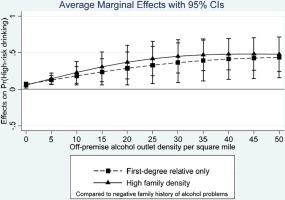Addictive Behaviors ( IF 3.7 ) Pub Date : 2020-09-29 , DOI: 10.1016/j.addbeh.2020.106668 Katherine J Karriker-Jaffe 1 , Karen G Chartier 2 , Cristina B Bares 3 , Kenneth S Kendler 4 , Thomas K Greenfield 1

|
Background
Effects of a family history of alcoholism may be moderated by area-level social control factors. We examine whether increased neighborhood alcohol availability (low social control environment) or increased presence of religious adherents in the county (high social control environment) interact with family history in relation to alcohol outcomes.
Methods
Weighted data from 12,686 adult drinkers (51% male; mean age 44; 80% White, 9% Black, 11% Hispanic) in three US National Alcohol Surveys were linked with data on area-level off-premise alcohol availability and adherence to religions with strong prohibitions against drinking. Family history density had four levels (family history negative, extended family only, first-degree relative(s) only, high family density). Dichotomous outcomes were past-year high-risk drinking and alcohol dependence. Logistic regression models with interaction terms assessed whether associations of family history with alcohol outcomes differed significantly by area-level social control. Stratified models assessed differences by sex and by race/ethnicity.
Results
In the full sample, effects of first-degree relatives and high family density on high-risk drinking strengthened as alcohol availability increased. This was replicated in the subsample of women and suggested in relation to dependence among men and Black drinkers. For White drinkers, higher religious social control reduced effects of first-degree relatives on high-risk drinking.
Conclusions
Low social control—in particular, greater density of off-premise alcohol outlets—appears to exacerbate effects of a family history of alcoholism on high-risk drinking. Policy makers should consider differential benefits of decreasing alcohol availability for people from high-risk families to reduce high-risk drinking and alcohol problems.
中文翻译:

美国全国成年人样本中家庭风险和环境社会控制对高危饮酒和酒精依赖的交叉影响
背景
酗酒家族史的影响可能会受到地区社会控制因素的影响。我们检查增加的邻里酒精供应(低社会控制环境)或该县宗教信徒的增加(高社会控制环境)是否与与酒精结果相关的家族史相互作用。
方法
在三项美国全国酒精调查中,来自 12,686 名成年饮酒者(51% 男性;平均年龄 44 岁;80% 白人,9% 黑人,11% 西班牙裔)的加权数据与地区级场外酒精供应和宗教信仰数据相关联严格禁止饮酒。家族史密度有四个级别(家族史阴性、仅大家庭、仅一级亲属、高家族密度)。二分类结果是过去一年的高风险饮酒和酒精依赖。具有交互项的逻辑回归模型评估了家族史与酒精结果的关联是否因地区级社会控制而显着不同。分层模型按性别和种族/民族评估差异。
结果
在整个样本中,一级亲属和高家庭密度对高风险饮酒的影响随着酒精供应量的增加而增强。这在女性的子样本中得到了复制,并与男性和黑人饮酒者之间的依赖有关。对于白人饮酒者,较高的宗教社会控制会降低一级亲属对高风险饮酒的影响。
结论
社会控制力低——尤其是店外酒精销售点的密度更大——似乎加剧了酗酒家族史对高危饮酒的影响。政策制定者应考虑减少高危家庭成员的酒精供应量以减少高危饮酒和酗酒问题的不同好处。











































 京公网安备 11010802027423号
京公网安备 11010802027423号